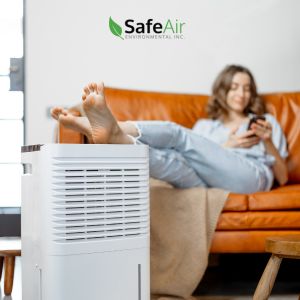How to Tell if Radon is a Threat?
Posted in Radon Testing, on August 21, 2023
Homeowners keen to improve their indoor environment with air quality testing in Toronto may have heard about adding radon testing to the list, but may be hesitating about the added cost or urgency. At SafeAir, we field many questions about home air quality, especially those about how dangerous various pollutants might be. Because radon gas is relatively unknown, has no smell, and is invisible, it’s easy to bypass or ignore — even though it affects hundreds of thousands of homes in Toronto.
What is Radon Gas?
 Radon is naturally produced radioactive gas in the earth’s crust and is present worldwide. When it dissipates into the atmosphere, radon is relatively harmless — but radon gas can collect in basements and homes in areas with a high concentration of uranium in the soil.
Radon is naturally produced radioactive gas in the earth’s crust and is present worldwide. When it dissipates into the atmosphere, radon is relatively harmless — but radon gas can collect in basements and homes in areas with a high concentration of uranium in the soil.
Why is Radon Gas Dangerous?
Radon gas is the second-most leading cause of lung cancer after tobacco smoke. The microscopic particles are easily breathed in and cause damage and inflammation in the lungs and respiratory system. While this damage takes years to accumulate, the effects are irreversible and are only noticed after it’s too late. Knowing whether or not radon affects your home air quality can help you avoid exposure and live in a healthy and safe environment.
How Radon Gas Enters Your Home
Radon gas enters homes through basements or sub-grade levels. As it’s released underground, it floats through the dirt and rocks that make up the earth’s surface. The change in ground pressure that our basements create draws radon gas towards them, and small gaps or cracks in the foundation allow it to enter.
How to Detect Radon Gas in Your Home?
How do you know if radon gas is entering your home? At SafeAir, we recommend that homeowners perform long-term radon testing in their homes as a stand-alone service or as part of an overall air quality assessment. While our physical senses can’t detect radon gas on their own, SafeAir uses a small device to monitor and detect the presence of radon. This testing device needs careful placement and needs to be installed for a minimum of 3-6 months to get accurate readings. Health Canada guidelines state that homes testing above 200 Bq/m3 are at risk and should take action to mitigate their risk.
How to Reduce Your Risk of Radon Gas
If we detect radon gas in your home, the next step is implementing strategies that reduce or eliminate your risk. Each home is going to have a different set of circumstances that we tailor our response to, but SafeAir may recommend doing things such as:
- Sealing foundation cracks.
- Sealing windows, doors, and other sub-grade entrances.
- Retrofitting sump pumps.
- Adding a radon filter to well-water pumps.
In severe cases where homes test above 600 Bq/m3, we may recommend more involved remediation efforts that use fans and sealed pipe systems to capture and divert radon gas.
During a cross-Canada survey, Health Canada found that approximately 7% of Canadians live in homes with unsafe radon levels. Test yours by booking comprehensive air quality testing in Toronto with SafeAir today.

